|
Sponsored by |
|---|
|
|
|
-
Need help navigating the forum? Find out how to use our features here.
-
Did you know we have lots of smilies for you to use?
You are using an out of date browser. It may not display this or other websites correctly.
You should upgrade or use an alternative browser.
You should upgrade or use an alternative browser.
Lunacy We all gotta eat, right? (Food Porn)
- Thread starter dorkus_molorkus
- Start date
Carnitas ‘street taco’ and spoon bread

bulllee
Well-Known Member
Just got a batch of really tasty ripe strawberries so I had to make some lemon curd to go with.

This stuff rocks, you can put it on anything....anything ! Your probably thinking....how long will it keep? IDK cause it only lasts one night around here. And it's not cause of me !
And it's not cause of me ! 
Homemade Lemon Curd
prep time
10 MINS
cook time
10 MINS
total time
20 MINS
Easy recipe for homemade lemon curd! Whip up this classic filling in just a few minutes. The tangy citrus flavor & buttery richness will wow you!
course: BREAKFAST, BRUNCH, DESSERT, TOPPING
cuisine: AMERICAN
keyword: HOW TO MAKE LEMON CURD, LEMON CURD, LEMON CURD RECIPE
servings: 16 OUNCES (APPROX)
calories: 99 KCAL
Ingredients
Instructions
Nutrition Facts
Homemade Lemon Curd
Amount Per Serving
Calories 99Calories from Fat 63
% Daily Value*
Fat 7g11%
Saturated Fat 4g25%
Cholesterol 83mg28%
Sodium 14mg1%
Potassium 23mg1%
Carbohydrates 7g2%
Fiber 1g4%
Sugar 6g7%
Protein 2g4%
Vitamin A 270IU5%
Vitamin C 3mg4%
Calcium 11mg1%
Iron 1mg6%
* Percent Daily Values are based on a 2000 calorie diet.
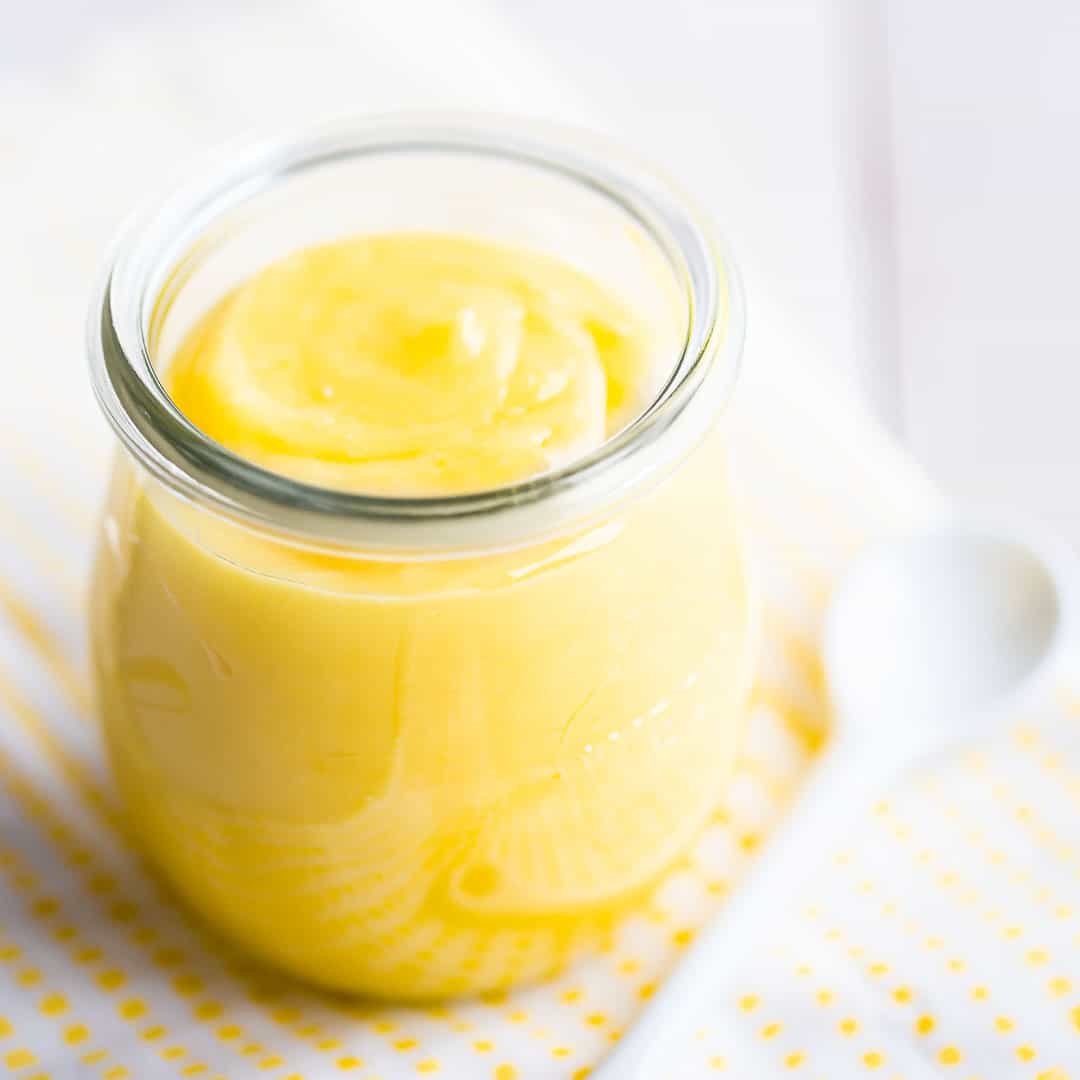
 bakingamoment.com
bakingamoment.com
This stuff rocks, you can put it on anything....anything ! Your probably thinking....how long will it keep? IDK cause it only lasts one night around here.
 And it's not cause of me !
And it's not cause of me ! Homemade Lemon Curd
prep time
10 MINS
cook time
10 MINS
total time
20 MINS
Easy recipe for homemade lemon curd! Whip up this classic filling in just a few minutes. The tangy citrus flavor & buttery richness will wow you!
course: BREAKFAST, BRUNCH, DESSERT, TOPPING
cuisine: AMERICAN
keyword: HOW TO MAKE LEMON CURD, LEMON CURD, LEMON CURD RECIPE
servings: 16 OUNCES (APPROX)
calories: 99 KCAL
Ingredients
- 3 eggs (large)
- 3 egg yolks (large)
- 1/2 cup granulated sugar
- 1/2 cup lemon juice (juice of 2 lemons)
- 1/2 cup unsalted butter (1 stick), cut into small pieces
Instructions
- Place the eggs, yolks, sugar, and lemon juice in a medium mixing bowl and whisk to combine.
- Place the bowl over a pot of simmering water, and add the butter.
- Cook, whisking continuously, until thickened. (The mixture should be about the consistency of yogurt. It will continue to thicken as it cools.)
- Place a fine mesh strainer over a heat-safe bowl, and pour the mixture through.
- Press waxed paper or plastic wrap directly onto the surface of the curd (to prevent a skin from forming), and refrigerate.
Nutrition Facts
Homemade Lemon Curd
Amount Per Serving
Calories 99Calories from Fat 63
% Daily Value*
Fat 7g11%
Saturated Fat 4g25%
Cholesterol 83mg28%
Sodium 14mg1%
Potassium 23mg1%
Carbohydrates 7g2%
Fiber 1g4%
Sugar 6g7%
Protein 2g4%
Vitamin A 270IU5%
Vitamin C 3mg4%
Calcium 11mg1%
Iron 1mg6%
* Percent Daily Values are based on a 2000 calorie diet.

Homemade Lemon Curd: Easy recipe, so tangy! -Baking a Moment
Easy recipe for homemade lemon curd! Whip up this classic filling in just a few minutes. The tangy citrus flavor & buttery richness will wow you!
Bcbud
Cannabis enthusiast
Well worth the time spent.
 www.food.com
www.food.com
Real Italian Bolognese Sauce Recipe - Food.com
After traveling throughout Italy, savoring the fine tastes of Bolognese from the many different regions, I decided to formulate my own. Try it, you'll
Madri-Gal
Well-Known Member
Yum. I haven't had spoon bread in forever.
bulllee
Well-Known Member
These are my brownies. I'll hazard some braggadocio and say these are like no others you've tried before. I made these for a birthday, and I didn't have any. Not my thing, I am the cookieman !  Everything your looking for in a brownie. Moist, chewy, thick dark chocolate floods your brain with endorphins. These are not for the faint of heart ! LOLOL Here's the recipe.
Everything your looking for in a brownie. Moist, chewy, thick dark chocolate floods your brain with endorphins. These are not for the faint of heart ! LOLOL Here's the recipe.

First thing get your 13" x 9" pan and coat pan with butter, then line with parchment paper that has been coated with butter. Set aside.
Now it's time to get your ganache working.
Ganache
8oz dark chocolate chopped up ( I like Trader Joe's Dark Belgian 72% )
1/4 C Dutch process cocoa
1 1/4 C melted butter
1 Tbls espresso powder (hard to find, it's not just ground coffee, sub freeze dried coffee crystals instead)
Melt your butter and blend in chocolate, cocoa, espresso powder and let sit and cool.
Batter
2 cups white sugar
1/2 c Dark brown sugar
6 whole eggs
2 tsp vanilla
2 tsp Kahlua coffee liquor
2 tsp kosher salt
So your gonna need to mix the eggs, sugars, vanilla, Kahlua, and salt and mix with a paddle for a full 5 minutes! That's a long time, but you want to incorporate as much air in batter as possible. Once mixed you are going to add your cooled ganache to the batter and blend.
Now add your flour, cocoa mixture to the batter and blend.
I recommend a stand mixer, but you can use a hand mixer, or if you are inclined you can do by hand but it's a bitch !
Dry items
1 C Flour ap
1/2 C cocoa powder
Blend together now your ready to pan your batter. Pour batter evenly over pan and smooth even.
Place in a 350 oven for 20 minutes. Now's the cool part is take your pan out and drop it on your counter( I use a towel underneath) I drop mine about 8 inches. What this does is it evens your crust out so it's not all lumpy and bumpy. Put back in the oven for another 25 minutes till done (use a toothpick) It should have risen nicely due to all that air being incorporated in the batter. Oh yeah toss a pinch of cayenne in your batter. It will really enhance the chocolate experience. Chill, then cut up using a hot knife dipped in hot water for a nice clean cut. Play around use different chocolates and stuff . I make a Grand Mariner brownie that's yummy.

 Everything your looking for in a brownie. Moist, chewy, thick dark chocolate floods your brain with endorphins. These are not for the faint of heart ! LOLOL Here's the recipe.
Everything your looking for in a brownie. Moist, chewy, thick dark chocolate floods your brain with endorphins. These are not for the faint of heart ! LOLOL Here's the recipe.First thing get your 13" x 9" pan and coat pan with butter, then line with parchment paper that has been coated with butter. Set aside.
Now it's time to get your ganache working.
Ganache
8oz dark chocolate chopped up ( I like Trader Joe's Dark Belgian 72% )
1/4 C Dutch process cocoa
1 1/4 C melted butter
1 Tbls espresso powder (hard to find, it's not just ground coffee, sub freeze dried coffee crystals instead)
Melt your butter and blend in chocolate, cocoa, espresso powder and let sit and cool.
Batter
2 cups white sugar
1/2 c Dark brown sugar
6 whole eggs
2 tsp vanilla
2 tsp Kahlua coffee liquor
2 tsp kosher salt
So your gonna need to mix the eggs, sugars, vanilla, Kahlua, and salt and mix with a paddle for a full 5 minutes! That's a long time, but you want to incorporate as much air in batter as possible. Once mixed you are going to add your cooled ganache to the batter and blend.
Now add your flour, cocoa mixture to the batter and blend.
I recommend a stand mixer, but you can use a hand mixer, or if you are inclined you can do by hand but it's a bitch !
Dry items
1 C Flour ap
1/2 C cocoa powder
Blend together now your ready to pan your batter. Pour batter evenly over pan and smooth even.
Place in a 350 oven for 20 minutes. Now's the cool part is take your pan out and drop it on your counter( I use a towel underneath) I drop mine about 8 inches. What this does is it evens your crust out so it's not all lumpy and bumpy. Put back in the oven for another 25 minutes till done (use a toothpick) It should have risen nicely due to all that air being incorporated in the batter. Oh yeah toss a pinch of cayenne in your batter. It will really enhance the chocolate experience. Chill, then cut up using a hot knife dipped in hot water for a nice clean cut. Play around use different chocolates and stuff . I make a Grand Mariner brownie that's yummy.
Stevenski
Enter the Dragon
This stuff rocks, you can put it on anything....anything ! Your probably thinking....how long will it keep? IDK cause it only lasts one night around here.And it's not cause of me !

Fuck. You sound just like my mum when she makes lemon curd

bulllee
Well-Known Member
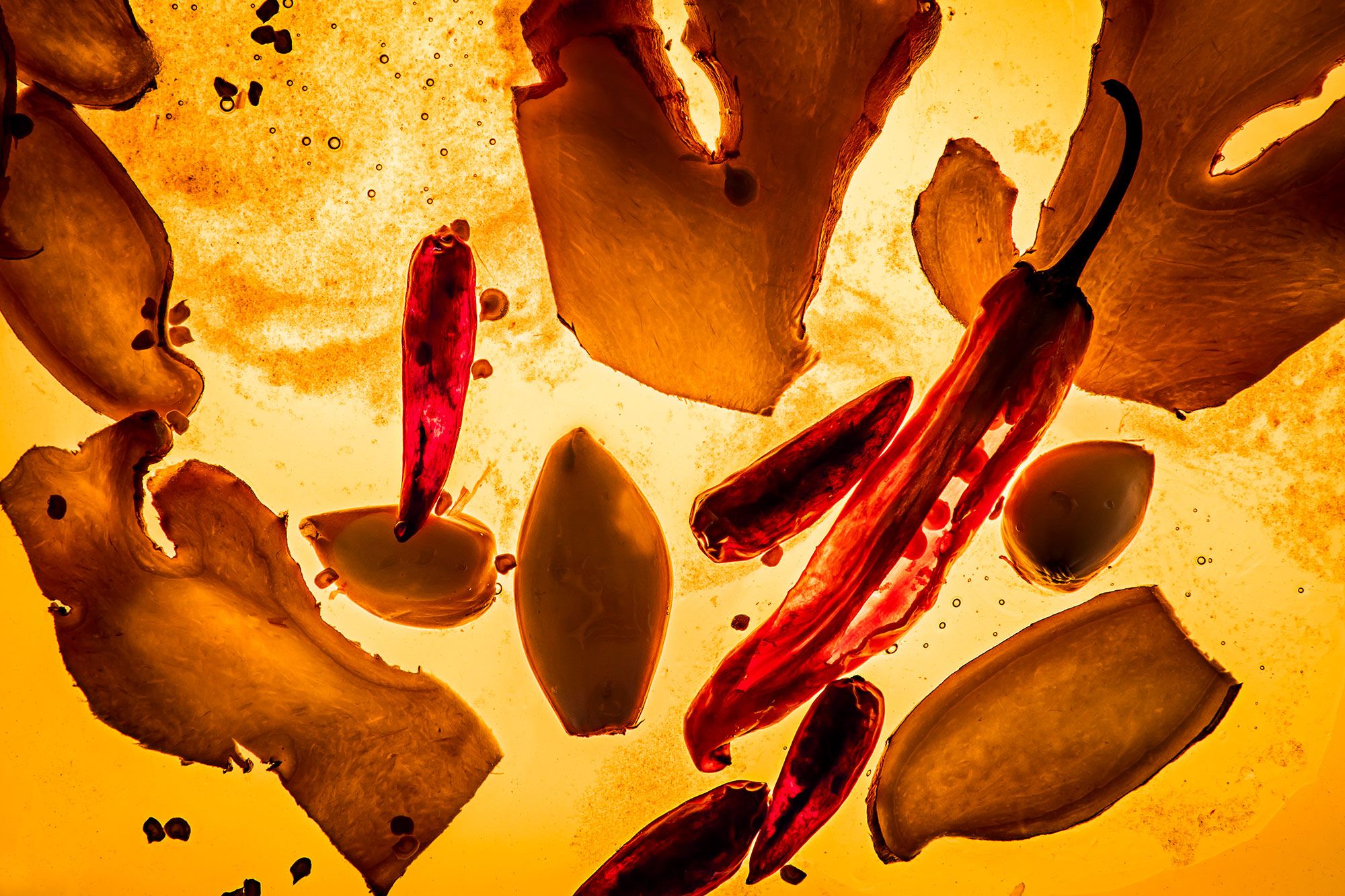
Fish Sauce Caramel Is the New Salted Caramel
Get to know the sweeter side of fish sauce.
Fish Sauce Caramel Is the New Salted Caramel
By: TATIANA BAUTISTA Photo: LIZZIE MUNRO
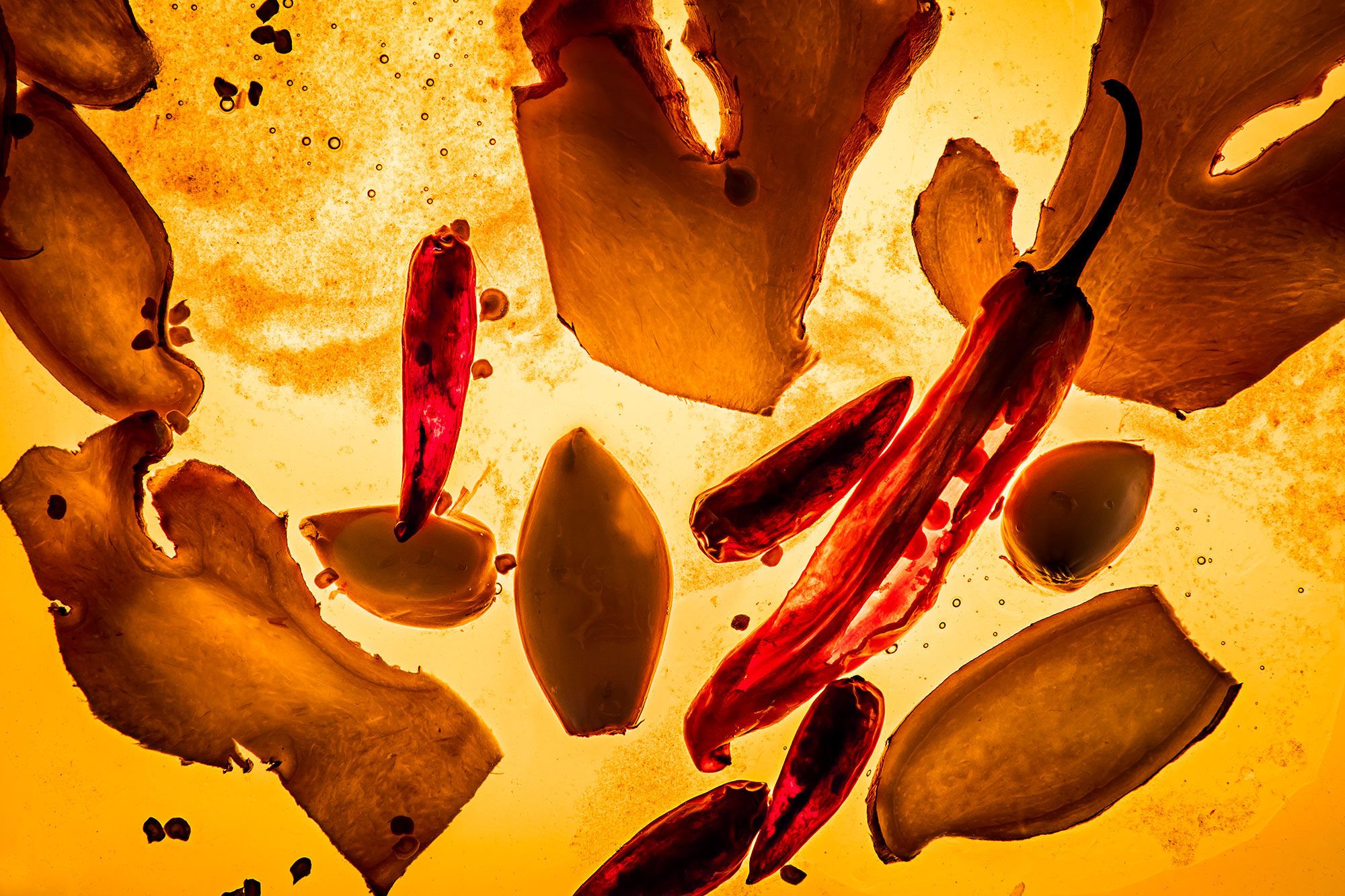
Get to know the sweeter side of fish sauce.
On its own, fish sauce packs a punch of briny piquancy. But to widen the world of fish sauce even more, just add some mellowing sugar and heat as a catalyst. Traditionally, fish sauce caramel is a combination that’s heavily embedded in homey, slow-cooked Vietnamese dishes, layered with umami and the slightest touch of bitterness. But the combination of inky sauce and liquid sugar has found a home in all types of home cooking. You can spot it in both tangy glazed chicken wings and creamy, wax-paper wrapped candies. And once you’ve mastered the basic harmony, the combo will change the way you think about every course of the meal.
In Vietnamese cooking, nuoc mau, a viscous, nearly blackened caramel sauce made with boiling hot water and sugar, combined with heaping spoonfuls of fish sauce, is used as a simmering liquid for stewy chunks of beef in bo kho and lends a glistening sheen to braised pork belly in thit kho tau. At its heart, nuoc mau isn’t so much a drizzling caramel for your sundae (more on that later), but rather a foundational sauce for savory dishes, since it’s cooked down to a bitter, molasses-like state.
For Nick Bognar, chef at Indo in St. Louis, the blueprint of nuoc mau plus fish sauce opens up a universe of marinades, finishing glazes, and dressings for many of his Southeast Asian–influenced dishes. His adaptation utilizes honey for more sweetness, in addition to palm sugar, plus aromatics that are infused into the liquid to bring out the crisp brightness of tropical herbs with a kick of spice. “It’s very much inspired by Vietnamese caramel sauce,” he says. “It’s sweet and salty with that underlying fish sauce flavor but made a little more complex with the addition of chiles, fresh lemongrass, and galangal.”
That same fish sauce caramel lays the groundwork for a grilled pork steak marinade before being wrapped in Bibb lettuce, then dipped in a funky naam prik and mingles with a fresh squeeze of lime and coconut milk in a lighter hamachi crudo. But for the everyday cook, the simple addition of acid turns fish sauce caramel into a salad dressing or fresh spring roll dipping sauce, not too far off from nuoc cham. When left alone, the syrupy sauce makes for an easy chicken wing coating, or better yet, a glaze for grilled ribs.
Flipping the script to caramel’s sweeter side, fish sauce brings its unmistakable funk and richness to desserts. “At first sight, a lot of people don’t equate fish sauce and confections together,” says Cecilia Leung, executive chef at Los Angeles café the Little Flower. But in developing a creamy caramel candy flavored with oak barrel remnants of the crystallized salt used to ferment the fish sauce, Leung reasons, “It’s delicate, rather than a punch in the face of eating fish sauce. You taste the saltiness like a typical salted caramel, but it definitely has tropical flavor to it, since there’s also palm sugar, which adds another layer of earthiness.”
Similarly, at Fat Rice in Chicago, fish sauce swaps places with salt, for a supercharged version of salted caramel to top a crispy rice dessert. Adrienne Lo, a partner at the restaurant, says that fish sauce brings out more intense notes than plain salt. It’s not necessarily that the end result tastes like fish, but that the fermented complexity beyond a sprinkling of salt revs up caramel’s familiar sugarcoated sweetness.
“It goes with anything that salted caramel sauce would go with,” says Lo. “Coffee, ice cream, chocolate, apples, toasted nuts, whatever!”
Fish Sauce Caramel
INGREDIENTS
1 ½ C fish sauce, preferably Shrimp brand
½ C brown sugar
1 C palm sugar
½ C honey
½ C whole garlic cloves
1 ½ C lemongrass, roughly chopped
4 pieces galangal, slivered
4 pieces whole fresh Thai chiles
4 pieces whole dried Thai chiles
At Indo in St. Louis, Nick Bognar uses a fish sauce caramel as a marinade, glaze, and finishing dressing for everything from hamachi crudo to pork steaks. Make a large batch and use it as a chicken wing glaze, or dilute it with a squeeze of fresh limes for a fresh dipping sauce for salads and rice-paper-wrapped spring rolls.
DIRECTIONS
- Combine all ingredients in large saucepot.
- Bring to boil, then turn down to medium-low heat.
- Let reduce by 10%, about 30 minutes to 1 hour.
- Let the mixture ste
Bcbud
Cannabis enthusiast
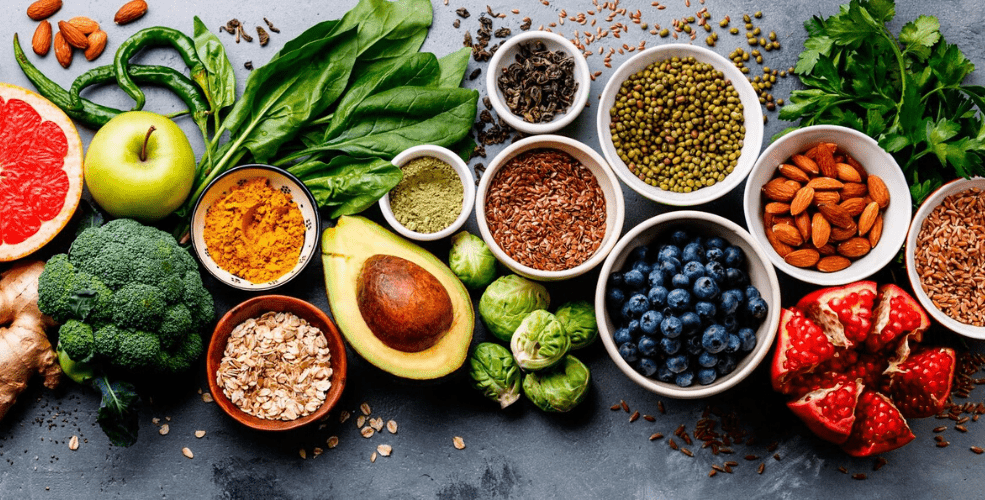
Healthy foods to eat that can improve and extend your marijuana high
Instead of the usual junk food you eat when you get the munchies, try these healthy foods that can boost your marijuana high and make it last longer.
bulllee
Well-Known Member
I always like Mangos. IDK if it helps your high ? There use to be a dispensary that gave you a little bag of dried mangos if you bought something. Mango Mondays was what they billed it as.
Healthy foods to eat that can improve and extend your marijuana high
Instead of the usual junk food you eat when you get the munchies, try these healthy foods that can boost your marijuana high and make it last longer.cannabislifenetwork.com
bulllee
Well-Known Member
https://www.tastecooking.com/how-to...paign=taste&utm_source=Crown&utm_medium=Email
Go On, Get the MSG
By: DANIEL HOLZMAN Photos: AARON BERNSTEIN
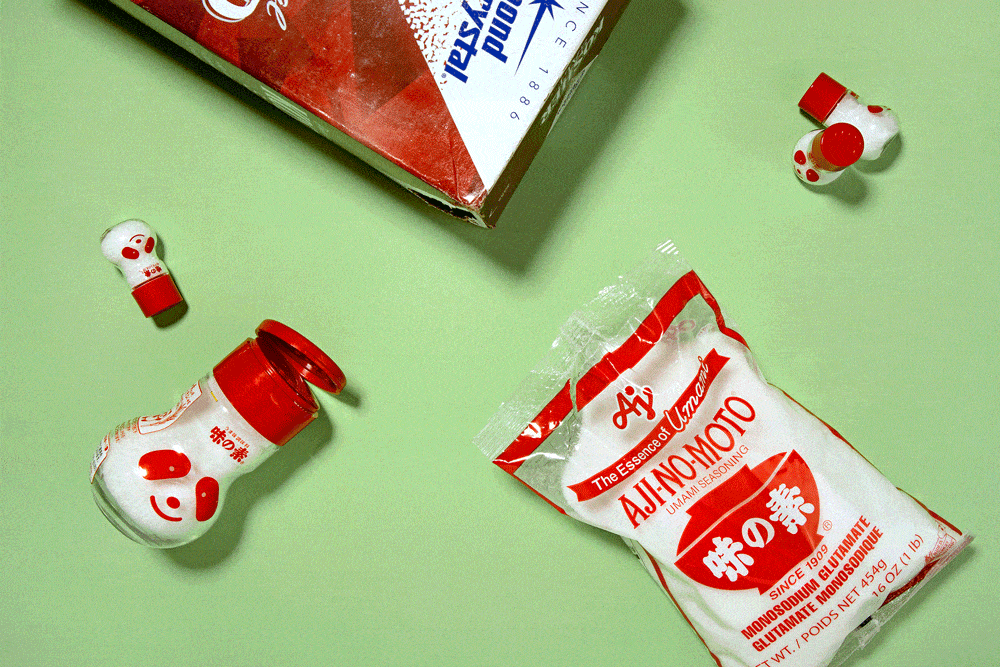
Padded with plenty of kosher salt, the seasoning can be the wind beneath your dinner’s wings.
In 1968, a letter published in the New England Journal of Medicine erroneously linked MSG—short for monosodium glutamate—to headaches and musculature pain. The article spawned a 50-year xenophobic attack on the safety of MSG and catalyzed a public health scare coined “Chinese restaurant syndrome.” Years after its scientific exoneration, the court of public opinion is still deliberating the ingredient’s place in a home kitchen—and there’s still little information on how to actually, properly, cook with MSG. This needed to change.
For years and years as a professional cook, and as a passionate home cook too, I have been a big proponent of cooking with MSG; it enhances and intensifies flavors and helps activate your taste buds so you can better taste your food. It’s that simple. If it’s added haphazardly, however, it can intensify mistakes and overwhelm the palate. Add a few too many pinches of allspice to your autumn root vegetable roast, and MSG could turn your mildly unpleasant misstep into a pumpkin-spice Hindenburg. This is why knowing how, and how much, MSG to use in various cooking techniques is imperative.
But first, buying MSG can be really confusing. There are numerous brands available, and brands call the stuff many different things: Badia brand’s offering is labeled simply “MSG,” while Accent brand’s product is labeled “Flavor Enhancer With 60% Less Sodium Than Salt.” A quick glance at the ingredients panel reveals that both products are exactly the same: pure monosodium glutamate.
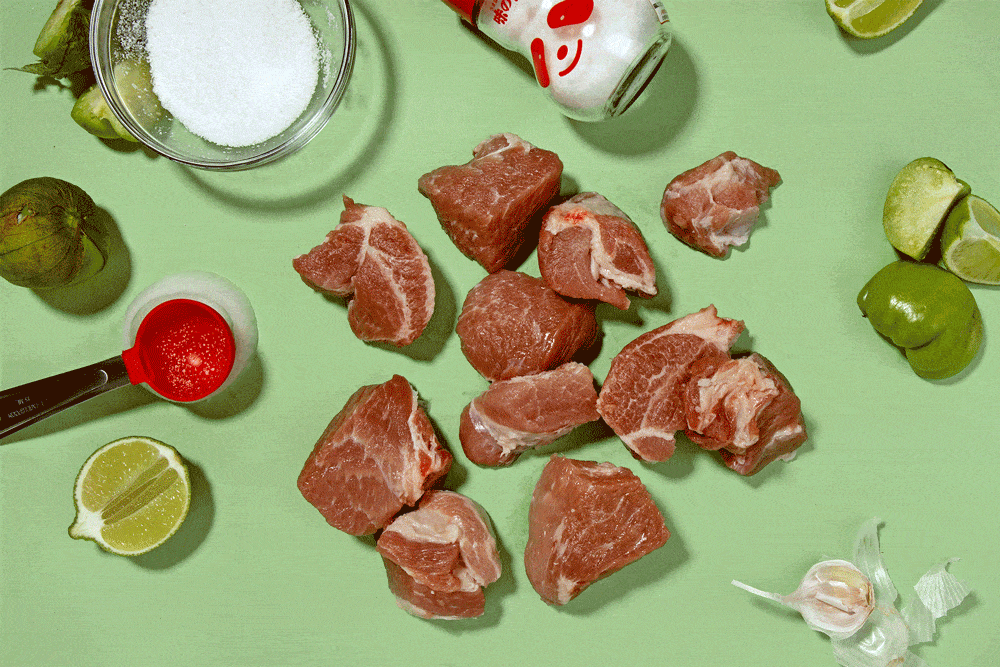
My favorite brand is a Japanese one, Ajinomoto, the company that discovered MSG in 1908. I honestly like Ajinomoto for no other reason than that the packaging is extremely cool, making it a slightly easier sell to my more obstinate friends with preconceived anti-MSG prejudices. But most of the other brands work well too. Just make sure to read the label to know what you are getting.
When placed on the tongue by itself, MSG tastes like a mild salt without any unique quality. This is because MSG doesn’t have any distinct flavor, so it doesn’t change the taste of food; rather, it adds a round and rich mouthfeel designated “umami,” or the fifth taste.
Because it doesn’t hold a specific flavor, save saltiness, the easiest way to incorporate the seasoning (and make sure you’re using the proper amount) is to create a blend: make a 10:1 mix of Diamond Crystal Kosher Salt to MSG, or roughly one tablespoon of MSG for every 2/3 cup of salt, and then season as you regularly would throughout your cooking process. Adding more MSG than the 10-to-1 ratio will overwhelm your taste buds, and your food will develop a distracting and lingering mouthfeel.
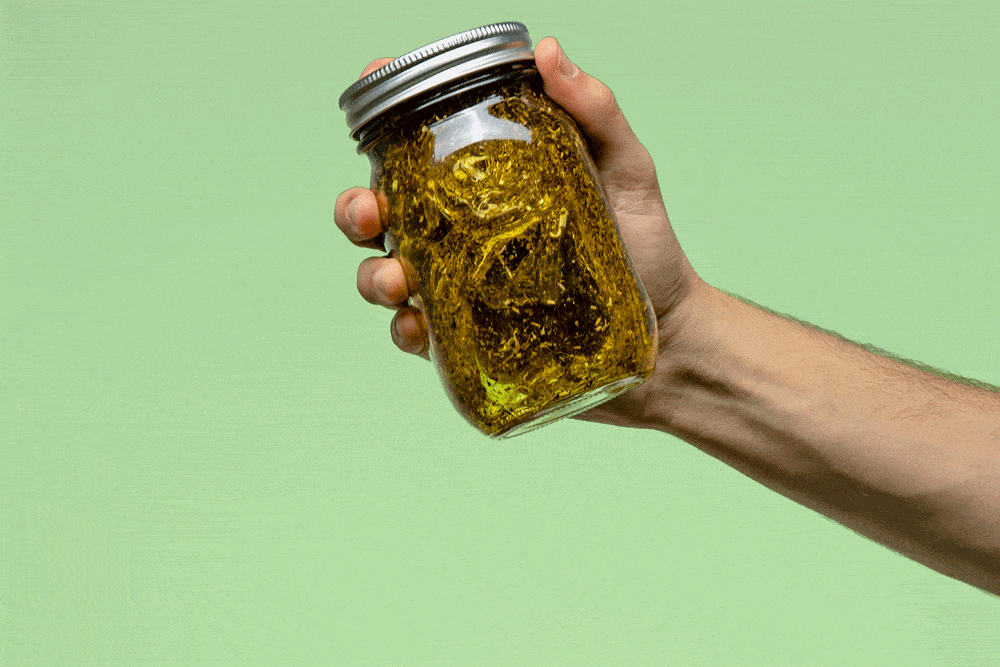
Different cooking methods require different applications of the MSG-salt blend, but it works extraordinarily well with meat and fish in the form of marinades and dry rubs. Seasoning in advance gives the salt time to penetrate the cell structure and migrate throughout the meat. (You can learn more about marinating meat in my previous article.)
For salads, pure MSG is best added directly to the dressing, giving it a chance to dissolve and distribute evenly throughout. For dry and fried foods like French fries, popcorn, potato chips, and onion rings, I add MSG at the very end so that it’s the first thing in contact with your tongue and has a chance to wake up your taste buds. Finally, I like using MSG as a finishing seasoning for roasted meats along with Sel Gris or Maldon salt—a light sprinkle after slicing does wonders to season inside and adds a punch of flavor that is otherwise impossible to achieve.
RECIPE: Pork, Tomatillo, and Charred Green Chile Stew
RECIPE: Ceviche With a Secret
Go On, Get the MSG
By: DANIEL HOLZMAN Photos: AARON BERNSTEIN

Padded with plenty of kosher salt, the seasoning can be the wind beneath your dinner’s wings.
In 1968, a letter published in the New England Journal of Medicine erroneously linked MSG—short for monosodium glutamate—to headaches and musculature pain. The article spawned a 50-year xenophobic attack on the safety of MSG and catalyzed a public health scare coined “Chinese restaurant syndrome.” Years after its scientific exoneration, the court of public opinion is still deliberating the ingredient’s place in a home kitchen—and there’s still little information on how to actually, properly, cook with MSG. This needed to change.
For years and years as a professional cook, and as a passionate home cook too, I have been a big proponent of cooking with MSG; it enhances and intensifies flavors and helps activate your taste buds so you can better taste your food. It’s that simple. If it’s added haphazardly, however, it can intensify mistakes and overwhelm the palate. Add a few too many pinches of allspice to your autumn root vegetable roast, and MSG could turn your mildly unpleasant misstep into a pumpkin-spice Hindenburg. This is why knowing how, and how much, MSG to use in various cooking techniques is imperative.
But first, buying MSG can be really confusing. There are numerous brands available, and brands call the stuff many different things: Badia brand’s offering is labeled simply “MSG,” while Accent brand’s product is labeled “Flavor Enhancer With 60% Less Sodium Than Salt.” A quick glance at the ingredients panel reveals that both products are exactly the same: pure monosodium glutamate.

My favorite brand is a Japanese one, Ajinomoto, the company that discovered MSG in 1908. I honestly like Ajinomoto for no other reason than that the packaging is extremely cool, making it a slightly easier sell to my more obstinate friends with preconceived anti-MSG prejudices. But most of the other brands work well too. Just make sure to read the label to know what you are getting.
When placed on the tongue by itself, MSG tastes like a mild salt without any unique quality. This is because MSG doesn’t have any distinct flavor, so it doesn’t change the taste of food; rather, it adds a round and rich mouthfeel designated “umami,” or the fifth taste.
Because it doesn’t hold a specific flavor, save saltiness, the easiest way to incorporate the seasoning (and make sure you’re using the proper amount) is to create a blend: make a 10:1 mix of Diamond Crystal Kosher Salt to MSG, or roughly one tablespoon of MSG for every 2/3 cup of salt, and then season as you regularly would throughout your cooking process. Adding more MSG than the 10-to-1 ratio will overwhelm your taste buds, and your food will develop a distracting and lingering mouthfeel.

Different cooking methods require different applications of the MSG-salt blend, but it works extraordinarily well with meat and fish in the form of marinades and dry rubs. Seasoning in advance gives the salt time to penetrate the cell structure and migrate throughout the meat. (You can learn more about marinating meat in my previous article.)
For salads, pure MSG is best added directly to the dressing, giving it a chance to dissolve and distribute evenly throughout. For dry and fried foods like French fries, popcorn, potato chips, and onion rings, I add MSG at the very end so that it’s the first thing in contact with your tongue and has a chance to wake up your taste buds. Finally, I like using MSG as a finishing seasoning for roasted meats along with Sel Gris or Maldon salt—a light sprinkle after slicing does wonders to season inside and adds a punch of flavor that is otherwise impossible to achieve.
RECIPE: Pork, Tomatillo, and Charred Green Chile Stew
RECIPE: Ceviche With a Secret
Bcbud
Cannabis enthusiast

Chocolate Kush Rocky Road Ice Cream for July 4th
Whatever you find yourself doing on July 4th, be sure to enjoy this Chocolate Kush rocky road ice cream to help you relax and cool off from the summer’s heat.
deep_meditation
Well-Known Member
https://www.tastecooking.com/how-to...paign=taste&utm_source=Crown&utm_medium=Email
Go On, Get the MSG
By: DANIEL HOLZMAN Photos: AARON BERNSTEIN

Padded with plenty of kosher salt, the seasoning can be the wind beneath your dinner’s wings.
In 1968, a letter published in the New England Journal of Medicine erroneously linked MSG—short for monosodium glutamate—to headaches and musculature pain. The article spawned a 50-year xenophobic attack on the safety of MSG and catalyzed a public health scare coined “Chinese restaurant syndrome.” Years after its scientific exoneration, the court of public opinion is still deliberating the ingredient’s place in a home kitchen—and there’s still little information on how to actually, properly, cook with MSG. This needed to change.
For years and years as a professional cook, and as a passionate home cook too, I have been a big proponent of cooking with MSG; it enhances and intensifies flavors and helps activate your taste buds so you can better taste your food. It’s that simple. If it’s added haphazardly, however, it can intensify mistakes and overwhelm the palate. Add a few too many pinches of allspice to your autumn root vegetable roast, and MSG could turn your mildly unpleasant misstep into a pumpkin-spice Hindenburg. This is why knowing how, and how much, MSG to use in various cooking techniques is imperative.
But first, buying MSG can be really confusing. There are numerous brands available, and brands call the stuff many different things: Badia brand’s offering is labeled simply “MSG,” while Accent brand’s product is labeled “Flavor Enhancer With 60% Less Sodium Than Salt.” A quick glance at the ingredients panel reveals that both products are exactly the same: pure monosodium glutamate.
My favorite brand is a Japanese one, Ajinomoto, the company that discovered MSG in 1908. I honestly like Ajinomoto for no other reason than that the packaging is extremely cool, making it a slightly easier sell to my more obstinate friends with preconceived anti-MSG prejudices. But most of the other brands work well too. Just make sure to read the label to know what you are getting.
When placed on the tongue by itself, MSG tastes like a mild salt without any unique quality. This is because MSG doesn’t have any distinct flavor, so it doesn’t change the taste of food; rather, it adds a round and rich mouthfeel designated “umami,” or the fifth taste.
Because it doesn’t hold a specific flavor, save saltiness, the easiest way to incorporate the seasoning (and make sure you’re using the proper amount) is to create a blend: make a 10:1 mix of Diamond Crystal Kosher Salt to MSG, or roughly one tablespoon of MSG for every 2/3 cup of salt, and then season as you regularly would throughout your cooking process. Adding more MSG than the 10-to-1 ratio will overwhelm your taste buds, and your food will develop a distracting and lingering mouthfeel.
Different cooking methods require different applications of the MSG-salt blend, but it works extraordinarily well with meat and fish in the form of marinades and dry rubs. Seasoning in advance gives the salt time to penetrate the cell structure and migrate throughout the meat. (You can learn more about marinating meat in my previous article.)
For salads, pure MSG is best added directly to the dressing, giving it a chance to dissolve and distribute evenly throughout. For dry and fried foods like French fries, popcorn, potato chips, and onion rings, I add MSG at the very end so that it’s the first thing in contact with your tongue and has a chance to wake up your taste buds. Finally, I like using MSG as a finishing seasoning for roasted meats along with Sel Gris or Maldon salt—a light sprinkle after slicing does wonders to season inside and adds a punch of flavor that is otherwise impossible to achieve.
RECIPE: Pork, Tomatillo, and Charred Green Chile Stew
RECIPE: Ceviche With a Secret
I use small amounts of MSG on a regular basis and haven't had any issues with it. I use it in soup, stews, bean dishes, etc. However, I guess I was using it haphazardly. I'll try the 10:1 ratio.
So many people worry about "MSG" at Chinese restaurants but they go to other restaurants and order food not realizing that it's probably lodaed with MSG and other flavor enhancers, etc.
bulllee
Well-Known Member
When I was younger I worked for a Greek family who owned a big Mexican restaurant that was very popular in the downtown area. They were especially known for their hot sauce and chips that they gave complimentary to every table. I worked as a waiter and in the kitchen. They had me making the hot sauce in 5 gallon batches everyday. Their secret ingredient ? Msg . The old greek guy called it "the magic" and they kept it locked up. They took it very serious, if people found out they would be ruined he said. I never thought about it till now. They went out of business a couple years ago. They did have the best hot sauce in town, it was a dark red chile, tomato sauce, heavy on the cumin and cracked black pepper. Simple but effective. Throughout the years I can't tell you about the number of people that were concerned about msg in their food. Msg is in a ton of stuff. That's why the industry calls it natural flavorings, or natural flavoring, plenty of other names they use. I started using it in my savory dishes a couple years ago and I must say all for the better. I don't use it in everything but I do use it in a lot of Asian inspired food. I never used the salt ratio till now. Great results.I use small amounts of MSG on a regular basis and haven't had any issues with it. I use it in soup, stews, bean dishes, etc. However, I guess I was using it haphazardly. I'll try the 10:1 ratio.
So many people worry about "MSG" at Chinese restaurants but they go to other restaurants and order food not realizing that it's probably lodaed with MSG and other flavor enhancers, etc.
bulllee
Well-Known Member
Something very cold and refreshing sounds good right about now. Idk why ? 
https://www.tastecooking.com/go-gra...paign=taste&utm_source=Crown&utm_medium=Email
Go Grand, Go Granita
By: THE TASTE EDITORS Photo: TASTE
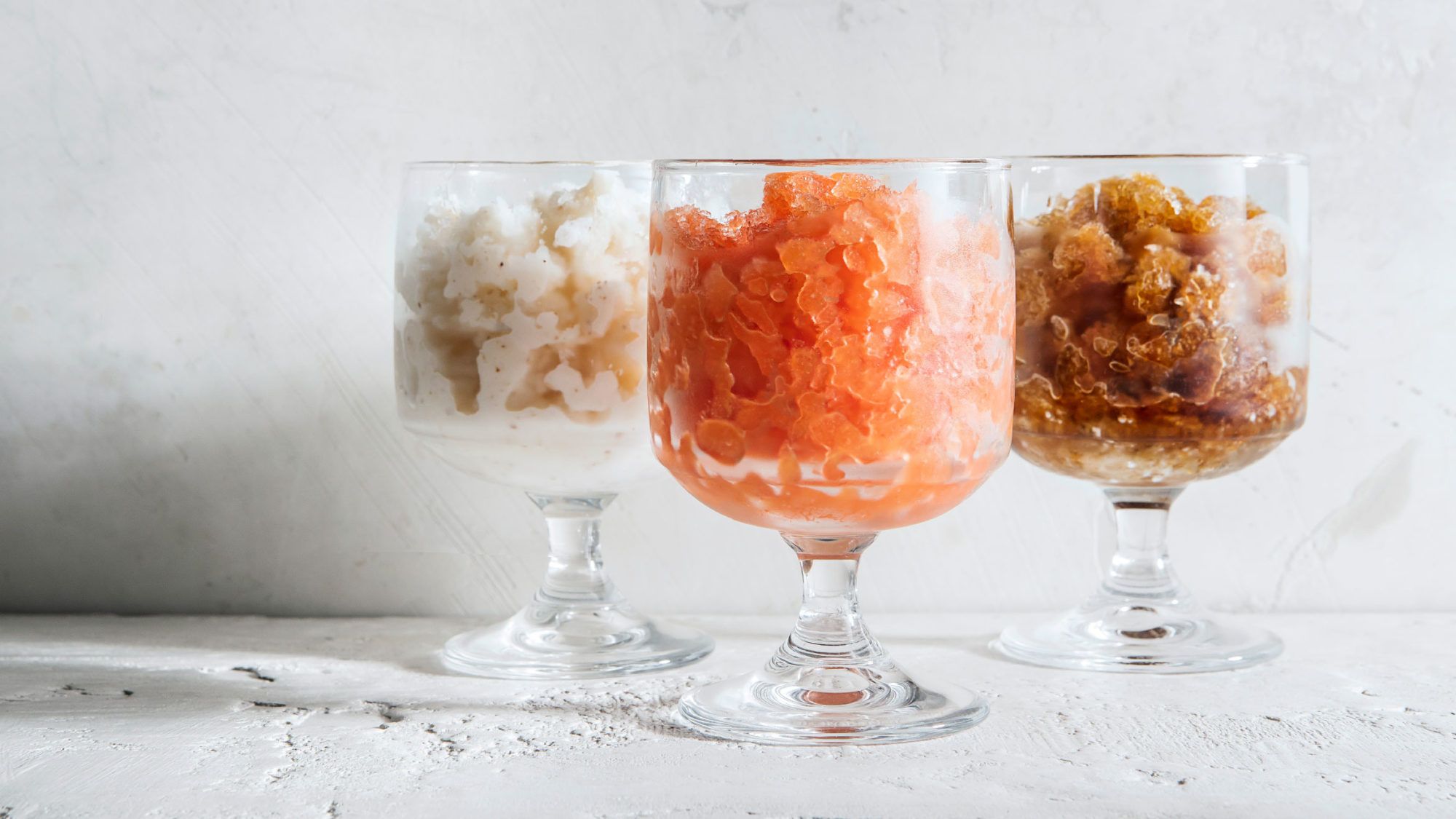
Layer it with gelato and crushed cookies, or just pile it into a glass with a spoonful of whipped cream.
Maybe your summer dessert secret weapon is your Vitamix, for on-demand strawberry smoothies—or, even better, an overflowing glass of icy halo-halo. Or maybe your tool of choice is a shaved ice machine, used for the sole purpose of making flaky mountains of kakigori and bingsu drizzled with sweetened condensed milk and covered with fresh fruit. But for a refreshing granita, the only pieces of technology you need are a shallow Tupperware container, a fork, a functioning freezer, and a bit of patience.
Halfway between a scoop of smooth sorbet and the coarse, technicolor syrup–doused granules of shaved ice, granita is defined by its lighter-than-air texture from loosely packed, grainy ice crystals. The basic technique for achieving this texture is as simple as gradually freezing a flavored base over the course of several hours, removing it from the freezer a few times along the way to scrape two forks back and forth across the surface to separate the crystals of ice from one another. Repeat a few times, and you have yourself the base for granita.
There’s a granita for every mood—whether you’re rescuing your over-ripened peaches, taking your cold brew to new heights, or trying to use up that last bit of almond paste. These three recipes from Laurie Ellen Pellicano revolve around the same idea: mix a flavorful liquid (like pureed fruit or coffee), simple syrup, and salt, and after a few rounds of fork scraping and freezing, you’ll be left with a balanced granita that’s flavorful, sweet, and icy. (It’s important to note that flavors dull when they freeze, so while you’re tasting the liquid, adjust for a mouth-puckering, intense flavor.) And better yet, you’ll be left with an ingredient that you can mix and match with your favorite gelato, amaro-tinted whipped cream, or crème fraîche, for a colorful, composed dessert.
Peach Granita
You could make a new granita every day of the week with the fruit of summer’s peak, but we’re partial to yellow peaches for their juicy, sunny sweetness and bright acidity. Pro tip: You can usually score a discount from farmers’ market “seconds” (the bumped, bruised, and nearly over-ripened fruits are actually ideal for making granita). When it’s ready to serve, make it a peaches-and-cream-inspired sundae of sorts—alternating the spoonfuls of slushy peach with velvety vanilla gelato and fresh peach slices.
Coffee Granita
This is iced coffee in the most literal sense. Make a cold brew granita for a refreshing reprieve on the muggiest of summer mornings. Turn it into a classic Sicilian-style breakfast and finish it off with a dollop of cream, plus a warmly toasted brioche bun on the side. And for a pick-me-up later in the day, pour a shot of your favorite amaro on top.
Almond Granita
Also popular in Italy, this granita relies on both almond paste and almond meal, mixed with water to give the final product creaminess and to build upon the almond’s toasty, nutty qualities. A spoonful of salted whipped cream (or coconut cream), crème fraîche, or mascarpone perfectly complements the rich, aromatic ice crystals.

https://www.tastecooking.com/go-gra...paign=taste&utm_source=Crown&utm_medium=Email
Go Grand, Go Granita
By: THE TASTE EDITORS Photo: TASTE

Layer it with gelato and crushed cookies, or just pile it into a glass with a spoonful of whipped cream.
Maybe your summer dessert secret weapon is your Vitamix, for on-demand strawberry smoothies—or, even better, an overflowing glass of icy halo-halo. Or maybe your tool of choice is a shaved ice machine, used for the sole purpose of making flaky mountains of kakigori and bingsu drizzled with sweetened condensed milk and covered with fresh fruit. But for a refreshing granita, the only pieces of technology you need are a shallow Tupperware container, a fork, a functioning freezer, and a bit of patience.
Halfway between a scoop of smooth sorbet and the coarse, technicolor syrup–doused granules of shaved ice, granita is defined by its lighter-than-air texture from loosely packed, grainy ice crystals. The basic technique for achieving this texture is as simple as gradually freezing a flavored base over the course of several hours, removing it from the freezer a few times along the way to scrape two forks back and forth across the surface to separate the crystals of ice from one another. Repeat a few times, and you have yourself the base for granita.
There’s a granita for every mood—whether you’re rescuing your over-ripened peaches, taking your cold brew to new heights, or trying to use up that last bit of almond paste. These three recipes from Laurie Ellen Pellicano revolve around the same idea: mix a flavorful liquid (like pureed fruit or coffee), simple syrup, and salt, and after a few rounds of fork scraping and freezing, you’ll be left with a balanced granita that’s flavorful, sweet, and icy. (It’s important to note that flavors dull when they freeze, so while you’re tasting the liquid, adjust for a mouth-puckering, intense flavor.) And better yet, you’ll be left with an ingredient that you can mix and match with your favorite gelato, amaro-tinted whipped cream, or crème fraîche, for a colorful, composed dessert.
Peach Granita
You could make a new granita every day of the week with the fruit of summer’s peak, but we’re partial to yellow peaches for their juicy, sunny sweetness and bright acidity. Pro tip: You can usually score a discount from farmers’ market “seconds” (the bumped, bruised, and nearly over-ripened fruits are actually ideal for making granita). When it’s ready to serve, make it a peaches-and-cream-inspired sundae of sorts—alternating the spoonfuls of slushy peach with velvety vanilla gelato and fresh peach slices.
Coffee Granita
This is iced coffee in the most literal sense. Make a cold brew granita for a refreshing reprieve on the muggiest of summer mornings. Turn it into a classic Sicilian-style breakfast and finish it off with a dollop of cream, plus a warmly toasted brioche bun on the side. And for a pick-me-up later in the day, pour a shot of your favorite amaro on top.
Almond Granita
Also popular in Italy, this granita relies on both almond paste and almond meal, mixed with water to give the final product creaminess and to build upon the almond’s toasty, nutty qualities. A spoonful of salted whipped cream (or coconut cream), crème fraîche, or mascarpone perfectly complements the rich, aromatic ice crystals.
bulllee
Well-Known Member
https://www.atlasobscura.com/articl...-70392897&mc_cid=da0f1c1381&mc_eid=c6e43d0902
How to Make Smoked Foods From Around the World on Your Stovetop
With advice and recipes from a renowned expert.
BY LUKE FATER JULY 1, 2020
How to Make Smoked Foods From Around the World on Your Stovetop
Steven Raichlen has been around the world four times documenting the different ways people cook food over fire. ALL ILLUSTRATIONS: CARMEN DEÑÓ FOR GASTRO OBSCURA

Steven Raichlen doesn’t know exactly how the first humans began smoking their food, but he has an idea. “We were probably sitting around a fire with strips of meat posted on sticks downwind of it, because we’d realized flies don’t like smoke,” he says. “And when we tasted that meat, not only were there no flies on it, but it had this amazing flavor, too.” He admits it’s pure conjecture, but having written the book on smoked foods, Raichlen is qualified to conject.
It was in the late 1990s, after earning a degree in French literature, winning a Watson Fellowship to study medieval cooking in Europe, and publishing several cookbooks that Raichlen had an epiphany. As he puts it, “Grilling is the world’s most universal cooking method, the most ancient cooking method, but everywhere it’s done differently.” He estimates he’s been around the world four times ever since, documenting the ways in which different cultures cook food over fire. He’s written more than two-dozen cookbooks, done Italian- and French-language cooking shows, and gone head-to-head with Tokyo’s Iron Chef—and won.
After all he’s learned about the timeless interplay between food and flame, smoking holds a special place in his repertoire. “Grilling is hot, fast, and theatrical, and barbecue is slow and iconic,” he says, “but smoking is really soulful, it’s flavorful.” Having visited a world of smokehouses, from the røgeri of the Danish Baltic Islands, to the smokehouses of Tokyo, to the jerk shacks of Kingston, Jamaica, he’s here to tell you that many of the recipes he collected in the making of his 2016 book and television show Project Smoke can be made at home with a stovetop wok-smoking method, using kitchen equipment you may already have. Here’s how.
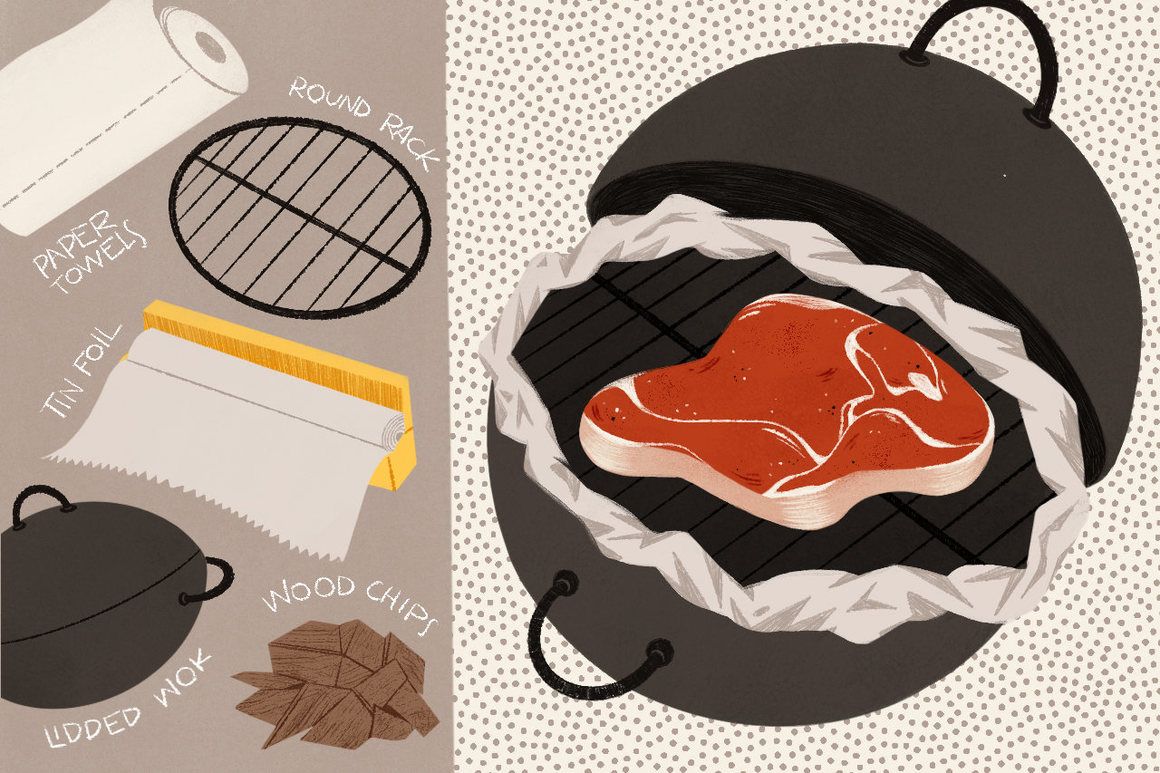 Raichlen’s stovetop smoker can be made with kitchen equipment you may already have.
Raichlen’s stovetop smoker can be made with kitchen equipment you may already have.
Raichlen’s method takes place entirely within a lidded wok. The food rests on a round rack within the wok while the smoke from heated chips on the bottom of the pan circulates throughout the sealed chamber. Being himself an expert, Raichlen doesn’t see the need to drill a hole in the wok lid to make room for a temperature gauge, but other instructors of this at-home method advise doing so.

You’ll only need a few items.
Once you have your food ready in the wok, place the lid on top and line the seal with damp paper towels, then again with tin foil. At this point, a ring of tin foil should encircle your wok, covering the area where the wok lid sits on the wok. Start your burner on high heat, then after 10 minutes, reduce to medium heat. The lid must be hermetically sealed; where there is smoke, there is leakage. Revisit with a wet paper towel and more tin foil.
When the wok is sealed and your stovetop burner is on, your food is smoking and you are underway. If you’re using a gauge, adjust the flame up or down to meet your recipe’s temperature needs.
Once you’re comfortable with this Raichlen-approved stovetop smoker, you can use Raichlen’s recipes to explore a whole world of smoked foods.
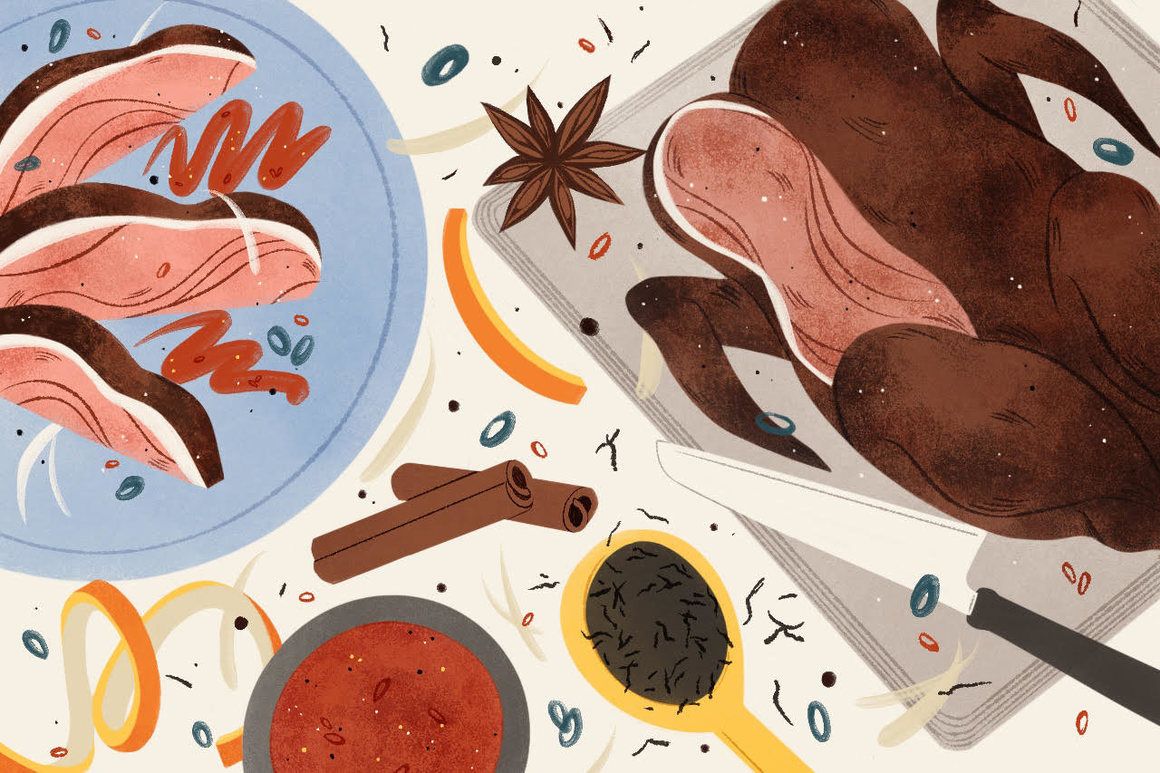 In addition to wood chips, tea-smoked duck calls for heating black tea, rice, orange peels, cinnamon, and star anise.
In addition to wood chips, tea-smoked duck calls for heating black tea, rice, orange peels, cinnamon, and star anise.
To get a taste of how our Mesolithic forebears ate, you can smoke oysters on the half-shell, mimicking how they cooked (and opened) shellfish by placing them on fire embers. You can put a smoky twist on deviled eggs—a dish whose history traces back to Ancient Rome. Or, you can experience the plank-smoking traditions developed by Native Americans in the Pacific Northwest, and apply it, in this case, to French cheese by smoking a wheel of camembert and serving it with jalapeños and pepper jelly. (These links all lead to recipes that can be made in your wok-based smoker.)
When you’ve mastered the basics, feel free to move on to more involved recipes. Asian ingredients such as dark sesame oil and dry-roasted peanuts meet the beloved chicken wing in this Pac-Rim smoked wings recipe. Add “smoky” to the sour, sweet, and spicy German-style potato salad you bring to your next cookout. Summertime also means tomato season, ideal for making a smokey Spanish gazpacho.
Ambitious indoor smokers can take on even more challenging dishes such as tea-smoked duck, smoked not only with wood chips but also loose black tea, white rice, orange peels, and spices in traditional Chinese fashion. Scandinavian salmon candy is an impeccable mashup of sweet, savory, and smoky that Raichlen recommends pairing with Norwegian aquavit. Raichlen’s take on smoked jerk chicken simulates traditional Jamaican jerk pits from the comfort of your own home, as long as your definition of “comfort” leaves room for a few thousand Scovilles.
Leave room for dessert: This tangerine smoked flan proves even your favorite sweets can be smoky too.
Gastro Obscura covers the world’s most wondrous food and drink.
How to Make Smoked Foods From Around the World on Your Stovetop
With advice and recipes from a renowned expert.
BY LUKE FATER JULY 1, 2020
How to Make Smoked Foods From Around the World on Your Stovetop
Steven Raichlen has been around the world four times documenting the different ways people cook food over fire. ALL ILLUSTRATIONS: CARMEN DEÑÓ FOR GASTRO OBSCURA
Steven Raichlen doesn’t know exactly how the first humans began smoking their food, but he has an idea. “We were probably sitting around a fire with strips of meat posted on sticks downwind of it, because we’d realized flies don’t like smoke,” he says. “And when we tasted that meat, not only were there no flies on it, but it had this amazing flavor, too.” He admits it’s pure conjecture, but having written the book on smoked foods, Raichlen is qualified to conject.
It was in the late 1990s, after earning a degree in French literature, winning a Watson Fellowship to study medieval cooking in Europe, and publishing several cookbooks that Raichlen had an epiphany. As he puts it, “Grilling is the world’s most universal cooking method, the most ancient cooking method, but everywhere it’s done differently.” He estimates he’s been around the world four times ever since, documenting the ways in which different cultures cook food over fire. He’s written more than two-dozen cookbooks, done Italian- and French-language cooking shows, and gone head-to-head with Tokyo’s Iron Chef—and won.
After all he’s learned about the timeless interplay between food and flame, smoking holds a special place in his repertoire. “Grilling is hot, fast, and theatrical, and barbecue is slow and iconic,” he says, “but smoking is really soulful, it’s flavorful.” Having visited a world of smokehouses, from the røgeri of the Danish Baltic Islands, to the smokehouses of Tokyo, to the jerk shacks of Kingston, Jamaica, he’s here to tell you that many of the recipes he collected in the making of his 2016 book and television show Project Smoke can be made at home with a stovetop wok-smoking method, using kitchen equipment you may already have. Here’s how.

Raichlen’s method takes place entirely within a lidded wok. The food rests on a round rack within the wok while the smoke from heated chips on the bottom of the pan circulates throughout the sealed chamber. Being himself an expert, Raichlen doesn’t see the need to drill a hole in the wok lid to make room for a temperature gauge, but other instructors of this at-home method advise doing so.

You’ll only need a few items.
- Lidded wok
- Round rack (that fits inside the wok)
- Tin foil
- Paper towels
- Woodchips
- Extra: drill and temperature gauge.
Once you have your food ready in the wok, place the lid on top and line the seal with damp paper towels, then again with tin foil. At this point, a ring of tin foil should encircle your wok, covering the area where the wok lid sits on the wok. Start your burner on high heat, then after 10 minutes, reduce to medium heat. The lid must be hermetically sealed; where there is smoke, there is leakage. Revisit with a wet paper towel and more tin foil.
When the wok is sealed and your stovetop burner is on, your food is smoking and you are underway. If you’re using a gauge, adjust the flame up or down to meet your recipe’s temperature needs.
Once you’re comfortable with this Raichlen-approved stovetop smoker, you can use Raichlen’s recipes to explore a whole world of smoked foods.

To get a taste of how our Mesolithic forebears ate, you can smoke oysters on the half-shell, mimicking how they cooked (and opened) shellfish by placing them on fire embers. You can put a smoky twist on deviled eggs—a dish whose history traces back to Ancient Rome. Or, you can experience the plank-smoking traditions developed by Native Americans in the Pacific Northwest, and apply it, in this case, to French cheese by smoking a wheel of camembert and serving it with jalapeños and pepper jelly. (These links all lead to recipes that can be made in your wok-based smoker.)
When you’ve mastered the basics, feel free to move on to more involved recipes. Asian ingredients such as dark sesame oil and dry-roasted peanuts meet the beloved chicken wing in this Pac-Rim smoked wings recipe. Add “smoky” to the sour, sweet, and spicy German-style potato salad you bring to your next cookout. Summertime also means tomato season, ideal for making a smokey Spanish gazpacho.
Ambitious indoor smokers can take on even more challenging dishes such as tea-smoked duck, smoked not only with wood chips but also loose black tea, white rice, orange peels, and spices in traditional Chinese fashion. Scandinavian salmon candy is an impeccable mashup of sweet, savory, and smoky that Raichlen recommends pairing with Norwegian aquavit. Raichlen’s take on smoked jerk chicken simulates traditional Jamaican jerk pits from the comfort of your own home, as long as your definition of “comfort” leaves room for a few thousand Scovilles.
Leave room for dessert: This tangerine smoked flan proves even your favorite sweets can be smoky too.
Gastro Obscura covers the world’s most wondrous food and drink.
Vegetarian Mousaka

Share:
|
Sponsored by |
|---|
|
|
|
 Dessert is strawberry crumble with ice cream.
Dessert is strawberry crumble with ice cream.